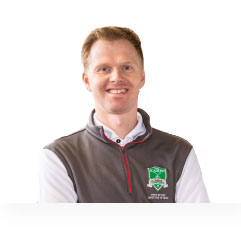 Pete Styles – PGA Teaching Pro
Pete Styles – PGA Teaching Pro
We’ve talked now about how important squaring the clubface is for most parts of your game and one part where it really is still very important is the shot game. Now the shot game – we don’t have such a difficult shot let’s say, we’re not 200 yards away from the green here; we might be 20 yards away from the green. But what makes it more difficult is that margin of error is quite tight now. We don’t just want to be on the green, we want to be on the right path to be, we want to be quite close to the flag particularly if you are a good golfer, a professional golfer you’ve got a 20 yard chip on. You want to leave yourself a nice sure putt on the other end to try and get on a good open down, to improve your score.
So the clubface needs to be very, very square, now it needs to be square to the target. We talked before about how it could be square to target, square to path. Now when we are playing short shots, it’s pretty much square to target, the only important thing because the ball when you are hitting with a wedge is not going to be up in the air long enough to create any fade or draw a curve. So there’s no point saying, “Well, I’m going to set it off left to the flag and draw or fade it back in or right and draw it back in. If you get the clubface square in your shot game the ball should fly pretty straight towards target and as long as it’s a flat green that you are rolling on it should roll up to the target.
Now one of the keys to getting set up correctly here is just making sure that the clubface is square in your address position. We see a lot of golfers almost don’t look at the golf club, they’re looking at the target working out where to land have a couple of little practise swings, stick the club in behind the ball and then struggle to square that clubface up. Also because you are using your wedges they have quite a curved rounded top and it sometimes even the front edge the sole plate is quite curved and rounded, so we have to look at the grooves. We have to really make sure the grooves on the clubface are exactly pointing towards our intended landing area or target.
So line the club up really square to target, take a nice set up, the stance may be open, the path of the swing maybe open, but the clubface should always remain square to target for standard chip or pitch shot, then as the club comes back and through we’re leading with that left shoulder chipping in a nice straight line. Now the one thing that might ruin that square clubface is overactive hand action. So you’ve lined it up square at setup and during the swing you’ve given it a better hand and that’s taken the club off line. So it’s quite important that during the set up and the swing we keep the left hand passive, we bring the left hand back and through keeping it nicely on line. And actually for a lot of golfers they could benefit from chipping one handed in practice, not on the course but in practice just to make sure that clubface is coming through really square.
So just left-handed chip shots back and through, back and through and just monitor which way the golf ball goes and if it’s going left there’s a chance you’ve over rotated your hands and if it’s going right the chance is you over rotated in the back swing, you opened the face here, didn’t close it back down and the ball goes off line. So a little one handed chip shots, it might be good of you have a nice lie or even a small tee peg to set the ball upon just so you can get good strikes. Pick a target, chip with one hand, see whether your clubface is opened or closed in your shot game.





